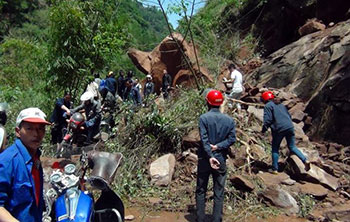A strong 6.6 magnitude earthquake has hit a remote, mostly rural and mountainous area of southwestern China’s Sichuan province, killing at least 102 people and injuring about 2,200 close to where a big quake killed almost 70,000 people in 2008.
The earthquake occurred at 8.02am (12.02pm New Zealand time) in Lushan county near Ya’an city and the epicentre had a depth of 12 km, the US Geological Survey said.
The quake was felt by residents in neighbouring provinces and in the provincial capital of Chengdu, causing many people to rush out of buildings, according to accounts on China’s Twitter-like Sina Weibo microblogging service.
State television said 102 people had been confirmed dead with more than 2,200 injured, 147 of them seriously.
President Xi Jinping and Premier Li Keqiang said all efforts must be put into rescuing victims to limit the death toll.
Li arrived in Chengdu and was on his way to the disaster zone by helicopter, state media said.
“The current most urgent issue is grasping the first 24 hours since the quake’s occurrence, the golden time for saving lives,” Xinhua news agency quoted Li as saying.
Xinhua said 6,000 troops were heading to the area to help with rescue efforts. State television CCTV said only emergency vehicles were being allowed into Ya’an, though Chengdu airport had reopened.
Most of the deaths were concentrated in Lushan, where water and electricity were cut off. Pictures on Chinese news sites showed toppled buildings and people in bloodied bandages being treated in tents outside the hospital, which appeared only lightly damaged.
Rescuers in Lushan had pulled 32 survivors out of rubble, Xinhua said. In villages closest to the epicentre, almost all low rise houses and buildings had collapsed, according to footage broadcast on state television.
A resident in Chengdu, 140 km from Ya’an city, told Xinhua he was on the thirteenth floor of a building when he felt the quake. The building shook for about 20 seconds and he saw tiles fall from nearby buildings.
Ya’an is a city of 1.5 million people and is considered one of the birthplaces of Chinese tea culture. It is also the home to one of China’s main centres for protecting the giant panda.
Shouts and screams were heard in the background while Reuters was on the telephone with the spokesman.
Sichuan is one of the four major natural-gas-producing provinces in China, and its output accounts for about 14% of the nation’s total.
M.D

